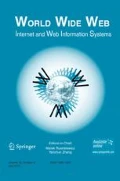Abstract
Templates are pieces of HTML code common to a set of web pages usually adopted by content providers to enhance the uniformity of layout and navigation of theirs Web sites. They are usually generated using authoring/publishing tools or by programs that build HTML pages to publish content from a database. In spite of their usefulness, the content of templates can negatively affect the quality of results produced by systems that automatically process information available in web sites, such as search engines, clustering and automatic categorization programs. Further, the information available in templates is redundant and thus processing and storing such information just once for a set of pages may save computational resources. In this paper, we present and evaluate methods for detecting templates considering a scenario where multiple templates can be found in a collection of Web pages. Most of previous work have studied template detection algorithms in a scenario where the collection has just a single template. The scenario with multiple templates is more realistic and, as it is discussed here, it raises important questions that may require extensions and adjustments in previously proposed template detection algorithms. We show how to apply and evaluate two template detection algorithms in this scenario, creating solutions for detecting multiple templates. The methods studied partitions the input collection into clusters that contain common HTML paths and share a high number of HTML nodes and then apply a single-template detection procedure over each cluster. We also propose a new algorithm for single template detection based on a restricted form of bottom-up tree-mapping that requires only small set of pages to correctly identify a template and which has a worst-case linear complexity. Our experimental results over a representative set of Web pages show that our approach is efficient and scalable while obtaining accurate results.
Similar content being viewed by others
References
Bar-Yossef, Z., Rajagopalan, S.: Template detection via data mining and its applications. In: Proceedings of the International Conference on the World Wide Web, pp. 580–591 (2002)
Beszteri, I., Vuorimaa, P.: Vertical navigation of layout adapted web documents. World Wide Web 10(1), 1–35 (2007)
Chakrabarti, S., Joshi, M., Tawde, V.: Enhanced topic distillation using text, markup tags, and hyperlinks. In: Proceedings the of ACM Conference on Research and Development in Information Retrieval, pp. 208–216 (2001)
Chakrabarti, D., Kumar, R., Punera, K.: Page-level template detection via isotonic smoothing. In: WWW ’07: Proceedings of the 16th International Conference on World Wide Web, pp. 61–70. ACM, New York, NY, USA (2007)
Chen, W.: New algorithm for tree-to-tree correction problem. J. Algorithms 40, 135–158 (2001)
Chen, L., Ye, S., Li, X.: Template detection for large scale search engines. In: SAC ’06: Proceedings of the 2006 ACM Symposium on Applied Computing, pp. 1094–1098. ACM, New York, NY, USA (2006)
Dalamagas, T., Cheng, T., Winkel, K.J., Sellis, T.K.: A methodology for clustering xml documents by structure. Inf. Syst. 31(3), 187–228 (2006)
de Castro Reis, D., Golgher, P.B., da Silva, A.S., Laender, A.H.F.: Automatic web news extraction using tree edit distance. In: Proceedings of the International Conference on the World Wide Web, pp. 502–511 (2004)
Debnath, S., Mitra, P., Giles, C.L.: Automatic extraction of informative blocks from webpages. In: ACM Symposium on Applied Computing, pp. 1722–1726 (2005)
Gibson, D., Punera, K., Tomkins, A.: The volume and evolution of web page templates. In: Proceedings of the International Conference on the World Wide Web—Poster Session, pp. 830–839. (2005)
Joshi, S., Agrawal, N., Krishnapuram, R., Negi, S.: A bag of paths model for measuring structural similarity in web documents. In: Proceedings of the Ninth ACM SIGKDD International Conference on Knowledge Discovery and Data Mining, Washington, DC, USA, pp. 577–582 (2003)
Khy, S., Ishikawa, Y., Kitagawa, H.: A novelty-based clustering method for on-line documents. World Wide Web 11(1), 1–37 (2008)
Lian, W., Cheung, D.W.L., Mamoulis, N., Yiu, S.M.: An efficient and scalable algorithm for clustering xml documents by structure. IEEE Trans. Knowl. Data Eng. 16(1), 82–96 (2004)
Macías, J.A.: Intelligent assistance in authoring dynamically generated web interfaces. World Wide Web 11(2), 253–286 (2008)
Nielsen, J.: User interface directions for the web. Commun. ACM 42(1), 65–72 (1999)
Nierman, A., Jagadish, H.V.: Evaluating structural similarity in XML documents. In: Proceedings of the International Workshop on the Web and Databases (2002)
Selkow, S.M.: The tree-to-tree editing problem. Inf. Process. Lett. 6, 184–186 (1977)
Song, R., Liu, H., Wen, J.R., Ma, W.Y.: Learning block importance models for web pages. In: Proceedings of the International Conference on the World Wide Web, pp. 203–211 (2004)
Tai, K.C.: The tree-to-tree correction problem. J. ACM 26(3), 422–433 (1979)
Valiente, G.: An efficient bottom-up distance between trees. In: Proceedings of the International Symposium on String Processing and Information Retrieval, pp. 212–219. IEEE Computer Science Press (2001)
Vieira, K., da Silva, A.S., Pinto, N., de Moura, E.S., Cavalcanti, J.M.B., Freire, J.: A fast and robust method for web page template detection and removal. In: Proceedings of the ACM International Conference on Information and Knowledge Management, Arlington, VA, USA, pp. 258–267 (2006)
Wang, J.T.L., Zhang, K.: Finding similar consensus between trees: an algorithm and a distance hierarchy. Pattern Recogn. 34, 127–137 (2001)
Yang, W.: Identifying syntactic differences between two programs. Softw. Pract. Exp. 21(7), 739–755 (1991)
Yi, L., Liu, B., Li, X.: Eliminating noisy information in web pages for data mining. In: Proceedings of the International ACM Conference on Knowledge Discovery and Data Mining, pp. 296–305 (2003)
Zhai, Y., Liu, B.: Extracting web data using instance-based learning. World Wide Web 10(2), 113–132 (2007)
Zhang, K., Statman, R., Shasha, D.: On the editing distance between unordered labeled trees. Inf. Process. Lett. 42(3), 133–139 (1992)
Author information
Authors and Affiliations
Corresponding author
Rights and permissions
About this article
Cite this article
Vieira, K., da Costa Carvalho, A.L., Berlt, K. et al. On Finding Templates on Web Collections. World Wide Web 12, 171–211 (2009). https://doi.org/10.1007/s11280-009-0059-3
Received:
Revised:
Accepted:
Published:
Issue Date:
DOI: https://doi.org/10.1007/s11280-009-0059-3




